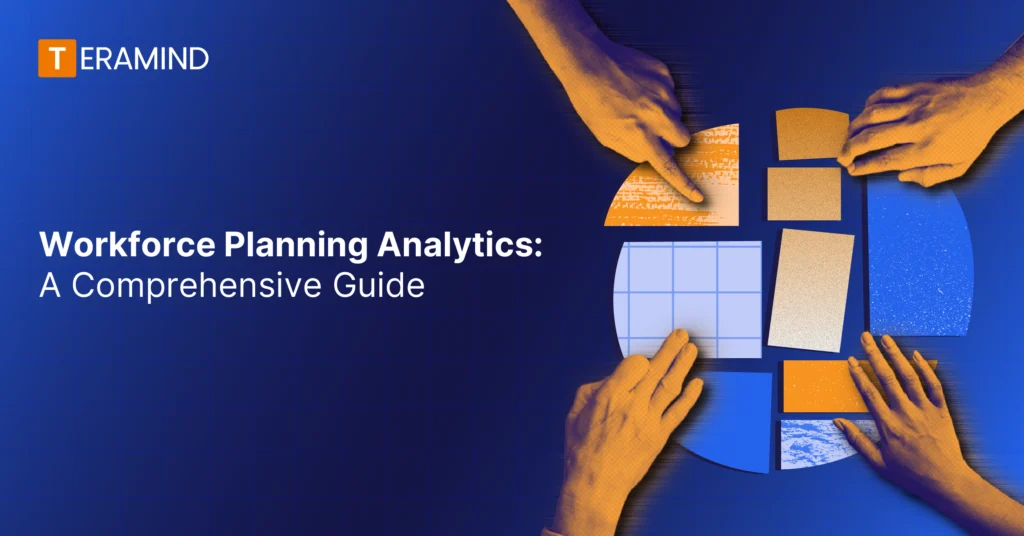Your business needs the right combination of talent and skills to meet performance goals. Workforce planning is essential for predicting staffing needs and ensuring your team has the necessary talent and resources. This process pinpoints skill gaps, anticipates employee turnover, and identifies plans of action.
For experienced HR leaders, getting the balance right isn’t guesswork. Instead, modern workforce management requires data-driven decision-making. In this article, we’ll cover everything you need to know about workforce planning analytics so you can implement a successful strategy and reach key productivity goals.
What is Workforce Planning Analytics?
Workforce planning analytics are insights people managers use to develop forecasts and make data-driven decisions about staffing needs and employee coverage. Also known as people analytics, these insights help HR leaders anticipate potential challenges and create actionable plans while meeting strategic business goals.
Why You Need Analytics in Workforce Planning
Workforce planning is based on your organization’s actual performance. As a result, you need data to forecast staffing needs and evaluate challenges. With workforce planning analytics, you can:
- Improve your decision-making capabilities: Use analytics to review past performance and set strategic objectives. Leverage data-driven insights to get stakeholder buy-in faster.
- Optimize costs and resource allocation: Identify where to cut costs and save money. At the same time, know where you need budget to upskill current employees or hire new talent.
- Enhance your ability to predict workforce needs: Pinpoint talent gaps and skills shortages so you can create a plan to address them. Use predictive analysis for more accurate forecasting.
- Strengthen your organizational agility: Avoid over-investing in unnecessary skills or job titles. This will improve your future potential and give your company a competitive edge.
Types of Workforce Analytics
Not all analytics for workforce planning are created equal. Here’s a closer look at the different types to track.
Descriptive Analytics
Descriptive analytics reflect your organization’s current and past performance. They describe historical data, such as employee retention, turnover, and employee demographics. However, they don’t provide context or cause for these outcomes.
Although they’re the most straightforward type of workforce analytics, they still provide important insights. Senior management can use them to get a quick overview of workforce efficiency or identify serious talent planning issues.
Diagnostic Analytics
Diagnostic analytics build on descriptive analytics by providing helpful context. They analyze historical data and explore the reasons for your organization’s current business environment.
For example, diagnostic analytics can identify factors contributing to outcomes like lower employee productivity or higher turnover rates. HR leaders can use these insights to make strategic decisions about factors like workforce gaps and talent acquisition.
Predictive Analytics
Predictive analytics forecast future performance. Instead of only reflecting on past business conditions, they use historical analytics to anticipate future outcomes.
This type of analytics is particularly helpful for forecasting skill gaps and talent supply issues that may pose problems in the near future. Savvy people managers can use these analytics to identify and address performance or oversupply issues before they escalate.
Prescriptive Analytics
Prescriptive analytics take predictive analytics a step further. In addition to forecasting future results based on historical data, they also propose the optimal actions to address these scenarios.
This type of advanced analytics is also the most actionable of the four. HR managers can use prescriptive analytics to plan headcount, develop hiring strategies, and meet future business goals.
Steps of Analytics-Driven Workforce Planning
To make the most of these analytics, you need a strategic workforce planning process. Follow the steps below to design a reliable workflow and build out a more effective talent management strategy.
1. Define organizational goals and objectives
To make informed decisions about workforce challenges, you first have to clarify what you want to achieve. What problem(s) do you need to solve? Start by defining your business objectives, which may require getting input from stakeholders.
For example, suppose your hiring budget for the next quarter has decreased by 25%. To get the most from this smaller budget, consider evaluating churn rates for each team and identifying job roles with the lowest cost-per-hire.
2. Collect and prepare relevant data
Once you’ve narrowed down your strategic goals, plan your data collection method. Let your goals guide the process and tools you adopt.
For instance, suppose you plan to assess employee engagement as part of your employee turnover analysis. In this case, pulse surveys may be a strong starting point. For a deeper dive into employee productivity and behavior metrics, Teramind is ideal for automated monitoring and analysis.
3. Analyze current workforce composition and trends
Next, analyze the data and identify workforce trends. Consider questions like:
- How do productivity levels compare across teams, job roles, and locations?
- How are employees using technology? Which applications do they use most and least?
- Has employee turnover changed over time? How about retention rates?
- What skills are most common in your workforce? How about combinations of skills?
- Are there significant differences in results for in-office, remote, and hybrid teams?
Use descriptive analytics to get a surface-level look at historical performance. Rely on diagnostic analytics to gain more context around performance across the entire organization.
4. Identify gaps between current and future states
Refer back to your objectives. Reflect on the difference between your current state and where you’d like to be. Consider questions like:
- What productivity level would you like all teams to achieve?
- Which applications would you like employees to use more or less often?
- What changes should you make to address talent needs and skill gaps?
- Which skills do you need to hire for or cultivate to plan for the future?
5. Develop and implement strategies to address gaps
Map out a strategy to tackle the gaps you identified. Use predictive analytics to forecast your organization’s future state based on past performance. Rely on prescriptive analytics to guide your action plan.
For example, you should prioritize employee engagement to boost retention in certain business units. You may also opt to roll out new website and app usage policies to increase productivity to specific levels.
6. Monitor and evaluate outcomes
Workforce planning isn’t something you can set and forget. Instead, plan to monitor the data continuously.
Decide on a timeline for reviewing the analytics. For instance, weekly or monthly reports often work best for quarterly goals. Share them with relevant stakeholders to keep everyone aligned on business decisions.
7. Continuously refine the process
Even the most thoughtful plans won’t serve your organization forever. As you review the data, remain open to adjusting your process as necessary — especially if your results are trending in the wrong direction.
Revisit the questions you asked earlier. Then, update your strategy and refine your process.
Key Metrics in Workforce Planning Analytics
Use these metrics to evaluate the business outcomes from your workforce planning strategies:
- Headcount and FTE (full-time equivalent): Assess your organization’s total employee numbers. These metrics reveal hiring trends and simplify the workforce planning process.
- Employee turnover and retention rates: Gain a better understanding of employee tenure. These metrics reveal employee attrition rates and show how well your organization retains talent.
- Time-to-hire and cost-per-hire: Evaluate the resources required for each hire. These metrics reveal how long the hiring process takes as well as the total cost, including labor costs and expenses.
- Employee performance metrics: Measure employee engagement and productivity. These metrics help you assess how committed and efficient your staff is, which can guide resource allocation.
- Skills inventory and gap analysis: Review the skills your staff has and identify where they fall short. These metrics inform talent development planning and ensure your team can meet future challenges.
- Workforce diversity and inclusion metrics: Analyze how well various groups are represented in your talent pool. These metrics ensure your workforce has a wide range of backgrounds and perspectives.
Leveraging Workforce Analytics with Teramind
With Teramind, you can collect and evaluate workforce analytics automatically. Teramind’s workforce monitoring software offers the solutions you need to identify critical trends and drive business growth.
Employee Productivity Monitoring
How do your employees spend their time while on the clock? What resources and software do they use most often? And most importantly, how actively do they work throughout the day?
Teramind’s employee productivity monitoring software tracks employee activity by both user and team. It also establishes productivity benchmarks for employees so you can spot trends efficiently.
Want to set custom goals that fit your business demands? Configure the key performance indicators (KPIs) that make the most business sense for your team so you can monitor what matters.
Comprehensive Behavior Analysis
How efficiently do your employees work? Is their productivity decreasing over time? How frequently do they create security risks or violate internal policies?
Teramind’s comprehensive behavior analysis software goes beyond basic productivity metrics. It explores the reasons for and potential consequences of employee behavior.
Through user activity monitoring, time-stamped screen recordings, and smart rules, you can automatically identify insider threats and address them before they present serious problems.
Hybrid Workforce Management
Are your remote and hybrid employees performing as well as on-site staff? Which regions drive the best performance and the highest productivity levels? Which employees create the greatest risk to your business?
Monitoring remote employee activity is easier than you might think. Teramind’s hybrid workforce management software provides a region-based breakdown of employee data.
This software monitors websites and apps for productivity and tracks keystrokes for security purposes. It’s designed to protect sensitive data and provide insights to guide operational workforce planning.
FAQs
What is WFM analytics?
WFM analytics, or workforce management analytics, involves using data and analytics to analyze and optimize workforce performance. It helps organizations make informed decisions about resource allocation, scheduling, and productivity improvement.
What is the role of HR analytics in workforce planning?
HR analytics plays a crucial role in workforce planning by providing insights and data-driven strategies for talent acquisition, retention, and development. By leveraging analytics, HR professionals can make informed decisions about workforce needs, identify skill gaps, and create effective strategies to optimize the workforce.
Is workforce analytics the same as HR Analytics?
Although there is some overlap, workforce analytics and HR analytics are not the same. While HR analytics focuses primarily on people management and HR-related processes, workforce analytics encompasses a broader scope, analyzing and forecasting workforce needs for strategic planning and decision-making.
Conclusion
Workforce planning is essential for achieving strong business performance and maintaining a competitive advantage. An analytics-driven approach to workforce planning allows you to make strategic decisions that align with your organization’s business initiatives.
Embracing data-driven HR practices doesn’t have to be difficult. With Teramind, you can collect workforce data automatically, providing key stakeholders with essential analytics to make smarter management decisions.


